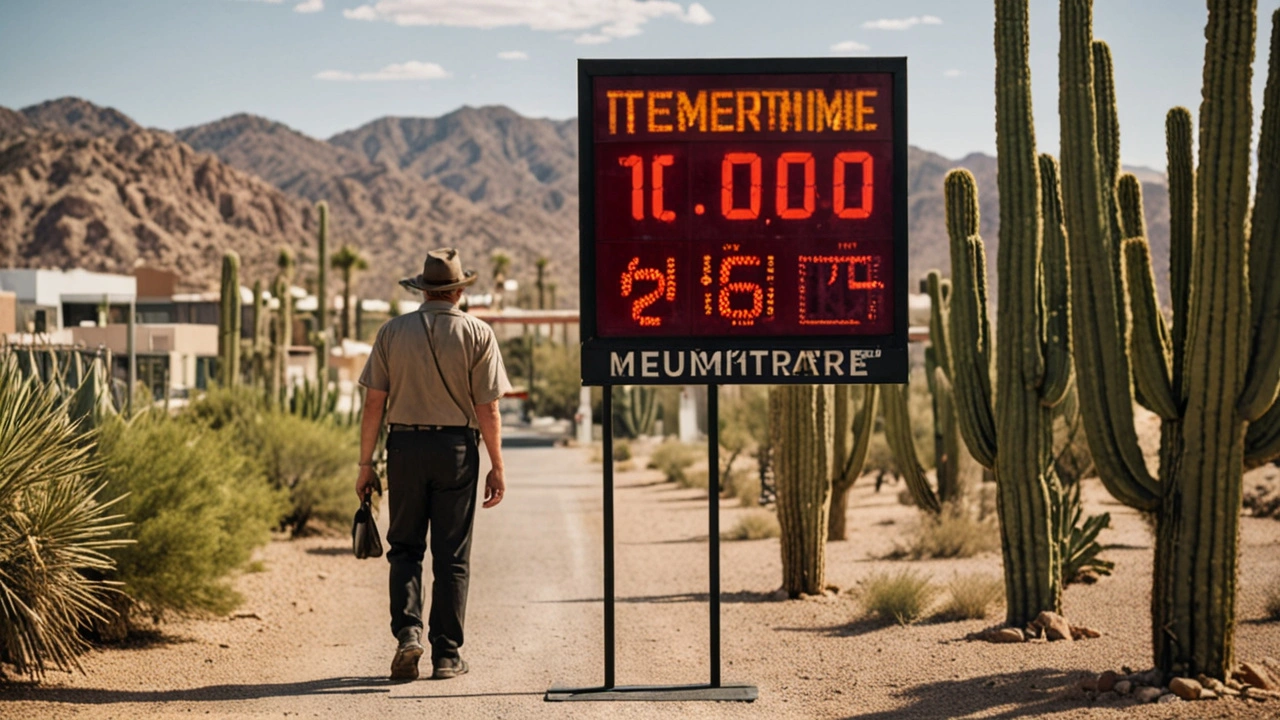Introduction to the Heat Dome Crisis
Astronomical heat levels are forecasted to sweep across the U.S. West Coast as an intense heat dome settles over the region. This phenomenon is expected to generate temperatures that could climb as high as 130 degrees Fahrenheit, affecting millions of individuals across multiple states, including California, Arizona, Oregon, Washington, and Nevada.
Understanding the Heat Dome Effect
A heat dome occurs when an area of high pressure acts like a lid, trapping warm air and preventing it from dissipating. This stagnant patch of high-pressure air creates persistently high temperatures, leading to dangerous heat waves. The abnormal weather system currently affecting the West Coast is set to shatter existing temperature records, underscoring the severity of the situation.
Regional Impacts and Record Predictions
Approximately 36 million Americans, translating to about 10% of the U.S. population, are predicted to feel the brunt of this heat dome. Concretely, temperatures are expected to average between 95 and 115 degrees Fahrenheit, significantly above normal summer levels. In regions like Redding, California, the temperature could be as much as 20 degrees Fahrenheit above average.
One of the areas most dramatically impacted will be Death Valley National Park. Known already for its extreme heat, the park could see temperatures soar up to an unprecedented 130 degrees Fahrenheit, setting new records even for this notoriously hot locale.
Wider Geographic Impact
It's not just isolated areas facing extreme temperatures; the heat advisories and watches cover a sprawling area, affecting an additional 37 million people on the West Coast. States like Arizona, Oregon, Washington, and Nevada are bracing for a similarly harsh rise in temperatures. The National Weather Service warns that these extreme conditions will persist through the week, pushing temperatures 15 to 30 degrees Fahrenheit above seasonal norms.

The Role of Human-Induced Climate Change
The intensifying heat wave isn't a standalone incident but rather a symptom of deeper issues related to climate change. Human activities continue to elevate global temperatures, leading to not only more frequent but also hotter and longer heat waves. The current crisis is a stark reminder of the pressing need for aggressive climate action.
Increased use of fossil fuels, deforestation, and other human activities are largely to blame for heightened greenhouse gas emissions, which trap heat in the atmosphere. This trapped heat contributes to the formation of extremities like the current heat dome, making such events a common occurrence rather than an anomaly.
Severe Consequences on Public Health
This extraordinary weather event has numerous implications, especially for public health. Prolonged exposure to unprecedented temperatures can lead to serious health risks such as heat strokes, dehydration, and worsening of preexisting conditions. Vulnerable populations, including the elderly, children, and those with chronic illnesses, are particularly at risk.
Emergency services and healthcare providers are gearing up for an influx of heat-related illnesses, emphasizing the need for immediate measures to protect public health. Authorities are urging residents to remain indoors during peak heat hours, stay hydrated, and make use of cooling centers to mitigate the impact.
Encompassing Preparedness Measures
With such drastic weather fluctuations, cities and states are taking both short-term and long-term actions. Short-term actions include issuing public service announcements, setting up cooling centers, and providing resources for at-risk communities. Long-term initiatives focus on developing better infrastructure to withstand extreme weather and adjusting urban planning to make cities more resilient.

Calls for Climate Action
The alarming temperatures have reignited calls for urgent climate action. Environmentalists and scientists argue that without significant interventions, such extreme weather events will become the norm rather than the exception. This could spell disaster not only for human health but also for entire ecosystems, agricultural productivity, and water resources.
Proponents of climate action emphasize the need for a multifaceted approach. This includes reducing greenhouse gas emissions, investing in renewable energy, and creating policies that encourage sustainable practices. The high temperatures serve as a wake-up call reminding us of the urgent need to address climate change.
Scientific Consensus and Public Awareness
Scientists globally agree that human actions are accelerating climate changes that lead to extreme weather phenomena like heat domes. Public awareness has surged, but translating awareness into action remains a crucial challenge. Educational campaigns aim to inform the public about simple but effective ways of contributing to climate action, like reducing energy consumption, recycling, and supporting green policies.
Conclusion: Navigating the New Normal
The unprecedented heat wave gripping the U.S. West Coast is a defining moment that underscores the urgency of addressing climate change. While immediate measures can mitigate some of the impacts, long-term solutions require concerted global effort. It's a complex but necessary path if we are to protect both our planet and future generations from increasingly extreme weather conditions.


Comments (11)
The recent heat dome enveloping the West Coast represents a stark manifestation of the atmospheric stagnation that modern climatology has long warned about. Such a high-pressure anomaly functions as a thermal lid, inhibiting convective dispersion and thereby allowing solar insolation to accumulate unchecked. Consequently, surface temperatures can proliferate to extraordinary magnitudes, eclipsing historical maxima by margins that are both statistically and meteorologically significant. In locales such as Death Valley, the projected thermic apex of 130 °F would not merely break records; it would redefine the climatological baseline for the region. This phenomenon is amplified by anthropogenic greenhouse gas concentrations, which have augmented the radiative forcing vector to unprecedented levels. The interrelationship between elevated carbon dioxide, methane, and nitrous oxide reservoirs and the propensity for persistent high-pressure blocks is a subject of rigorous peer‑reviewed investigation. Moreover, the enthalpic surplus generated under these conditions strains urban infrastructure, overwhelms power grids, and precipitates acute public health crises. Heat‑related morbidity, particularly among the elderly, pediatric, and chronically ill populations, escalates in direct proportion to the ambient temperature gradient. Emergency response agencies, therefore, must orchestrate a multipronged strategy encompassing cooling shelters, expanded hydration stations, and real‑time public advisories. From a policy perspective, the urgency of curbing fossil‑fuel combustion and accelerating renewable energy adoption cannot be overstated. Legislative inertia, however, remains a formidable obstacle, as evidenced by the tepid progress of carbon‑neutral pledges at both state and federal tiers. The juxtaposition of scientific consensus against political equivocation engenders a dissonance that hampers effective mitigation. It is incumbent upon informed citizens to galvanize community action, leveraging both grassroots initiatives and institutional channels. Only through a concerted, data‑driven mobilization can we hope to attenuate the frequency and intensity of such thermic aberrations. In summation, the heat dome episode is not an isolated anomaly but a clarion call to reexamine our collective environmental stewardship.
The heat is simply an incidental consequence of climate inertia.
For anyone navigating these soaring temperatures, hydration is paramount; aim for at least eight ounces of water every hour if you’re outdoors. Seek out designated cooling centers, many of which are operating extended hours during heat emergencies. Limit strenuous activity to the early morning or late evening when the mercury is lower, and wear loose, light‑colored clothing to reflect sunlight. Check on vulnerable neighbors-especially the elderly and those with chronic conditions-to ensure they have access to cool environments and sufficient fluids. Lastly, stay informed by following local health advisories and weather updates.
Our great nation has weathered countless trials, and this heat wave is no different; we will endure and prevail. It’s a stark reminder that the resilience of American infrastructure must match the ferocity of nature. While some point fingers abroad, the real issue lies in our own consumption habits that fuel such extremes. Let’s rally behind policies that protect our homeland and our citizens from these relentless temperature spikes.
Wow, this heat is insane 😓-I can barely step outside without feeling like I’m in an oven! Stay safe, folks, and remember to drink plenty of water 💧. If you can, grab a cold drink, find some shade, and avoid the midday sun. And don’t forget those cooling centers; they’re a lifesaver right now 😊.
Man, that dome is wild. Hope everyone’s got a plan to stay cool-hit the AC, keep a fan running, and don’t overdo the BBQs. If you’re stuck at home, crank up the music and maybe binge a series with some ice cream. Stay chill, everybody!
Hey, I totally get how freaky this feels; it’s like the planet’s firing up a giant grill. Just take it easy, keep a water bottle handy, and remember to check in on the folks next door. A little kindness goes a long way when it’s this scorching out.
The data shows a rise. It is clear. The numbers dont lie. This is a serious issue.
I appreciate the factual tone, but let’s also consider actionable steps that bridge science and community effort. Promoting local green spaces and encouraging energy‑saving measures can mitigate future heat spikes. Together, we can foster resilience without sacrificing practicality.
i think we need to re evalute our values and see how we can do better. This heat is like a mirror reflectin our habits.
Honestly, if you’re still clueless about why this is happening, maybe do some reading. Ignorance isn’t an excuse when the thermometer keeps climbing. Get informed, or you’ll keep getting burned.